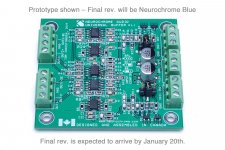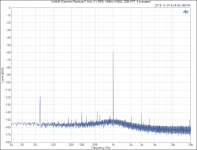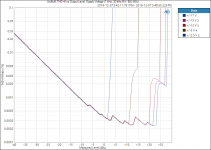As requested: Here's the link to the Universal Buffer thread, which just launched: Universal Buffer achieving -140 dBc (0.00001 %) THD
The Universal Buffer replaces my previous THAT Driver and THAT Receiver circuits. It also improves all performance parameters - many of them by orders of magnitude!
Tom
The Universal Buffer replaces my previous THAT Driver and THAT Receiver circuits. It also improves all performance parameters - many of them by orders of magnitude!
Tom
Hi Tom,
Looking at the 4th attachment would seem to suggest 0.0006% THD approximately, worse at higher frequencies of course. I really don't think it is reasonable to expect your distortion is running around -140 dB, given that the passive components would be adding their own distortion rates. What ICs were you using? They may also be under-performing.
Having said that, the performance is very, very good. I am interested in your project.
-Chris
Looking at the 4th attachment would seem to suggest 0.0006% THD approximately, worse at higher frequencies of course. I really don't think it is reasonable to expect your distortion is running around -140 dB, given that the passive components would be adding their own distortion rates. What ICs were you using? They may also be under-performing.
Having said that, the performance is very, very good. I am interested in your project.
-Chris
Looking at the 4th attachment would seem to suggest 0.0006% THD approximately, worse at higher frequencies of course.
Um. No... It shows 0.0006% THD+N.
I really don't think it is reasonable to expect your distortion is running around -140 dB, given that the passive components would be adding their own distortion rates.
I use metal film SMD resistors with low temperature coefficient and low voltage coefficient. I further design the circuit to minimize any perturbation to the signal that the passives might cause. The amount of distortion they add is negligible, even at the -140 dB level.
You're certainly in your right to be skeptical of my -140 dB THD measurement. That was hard to do! I ended up using an active 1 kHz notch filter designed around an LME49720 and a handful of 0.1% tolerance metal film resistors and polypropylene capacitors. Using it and my "Victor's Oscillator", I verified that the distortion of the oscillator was below -145 dB.
I then adjusted the oscillator for 2 V output on the Universal Buffer and connected the notch filter between the Buffer and the APx525. The resulting THD residual is shown in the attached FFT plot.
I did verify my THD measurement with a passive (twin-T) notch filter as well. The main drawback of the passive filter is that it attenuates the harmonics, so one needs to compensate accordingly when reading the plots. The active filter I used for the FFT measurement of the Universal Buffer has negligible attenuation (< 0.5 dB) of the harmonics.
What ICs were you using? They may also be under-performing.
I'm using the LM4562/LME49720 and the LME49724. You can find the block diagram on the Circuit Topology tab of the product page.
I never thought I'd hear -140 dB THD called "underperforming". 🙂 The LME49724 is spec'ed for -130 dB at heavy load (down to 600 Ω). I'm measuring at light load (100 kΩ) where its distortion is lower. Same for the LM4562/LME49720. All this is covered in the notes column of the spec table.
Having said that, the performance is very, very good. I am interested in your project.
Sounds great. I'm ready for your preorder... 😉
I've attached the board picture and the two measurements we're talking about to give people in this thread enough context. I welcome the conversation, but suggest we scoot to the Universal Buffer thread for further discussion related to it: Universal Buffer achieving -140 dBc (0.00001 %) THD
Tom
Attachments
-
 UNIBUFF_Proto_1p1.jpg452.6 KB · Views: 458
UNIBUFF_Proto_1p1.jpg452.6 KB · Views: 458 -
 UniBuff_ Distortion Residual (1 kHz, 2 V RMS, UNBAL-UNBAL, 256k FFT, 8 averages).PNG45.1 KB · Views: 466
UniBuff_ Distortion Residual (1 kHz, 2 V RMS, UNBAL-UNBAL, 256k FFT, 8 averages).PNG45.1 KB · Views: 466 -
 UniBuff_ THD+N vs Frequency (2 V RMS, 60 kHz BW, BAL-BAL).PNG35.8 KB · Views: 421
UniBuff_ THD+N vs Frequency (2 V RMS, 60 kHz BW, BAL-BAL).PNG35.8 KB · Views: 421 -
 UniBuff_ THD+N vs Output Level, Supply Voltage (1 kHz, 20 kHz BW, BAL-BAL).PNG51.4 KB · Views: 416
UniBuff_ THD+N vs Output Level, Supply Voltage (1 kHz, 20 kHz BW, BAL-BAL).PNG51.4 KB · Views: 416
Last edited:
Hi Tom,As requested: Here's the link to the Universal Buffer thread, which just launched: Universal Buffer achieving -140 dBc (0.00001 %) THD
The Universal Buffer replaces my previous THAT Driver and THAT Receiver circuits. It also improves all performance parameters - many of them by orders of magnitude!
Tom
Can I ask if you expect this buffer to provide better results than that of the Differential preamp I am using?
Thanks
Oliver.
Hi Tom,
Merry Christmas, and thank you for your reply. I'm using Victor's oscillators and an RTX 6001 for my measurements. I'll have a look at your links.
Best, Chris
Merry Christmas, and thank you for your reply. I'm using Victor's oscillators and an RTX 6001 for my measurements. I'll have a look at your links.
Best, Chris
Can I ask if you expect this buffer to provide better results than that of the Differential preamp I am using?
If you're comparing with my Differential Preamp 8x2, you can expect roughly 20 dB improvements in noise and THD, and a nearly 30 dB improvement in multi-tone IMD. The CMRR of the Universal Buffer is a little lower, however, as I'm using ±0.1% tolerance resistors on the PCB rather than better matched resistors on-die as THAT is using. In theory, the CMRR is, thus, limited to 60 dB, but I generally measure above 80 dB mid-band.
Tom
Wow. That's a large enough margin to get my attention.If you're comparing with my Differential Preamp 8x2, you can expect roughly 20 dB improvements in noise and THD, and a nearly 30 dB improvement in multi-tone IMD. The CMRR of the Universal Buffer is a little lower, however, as I'm using ±0.1% tolerance resistors on the PCB rather than better matched resistors on-die as THAT is using. In theory, the CMRR is, thus, limited to 60 dB, but I generally measure above 80 dB mid-band.
Tom
3 in, 1 out.
I presume I'd need more than 1 PCB?
What's the power requirements of such a thing.
Edit: Ignore me, just had a good look at the PCB.
2 in, 2 out with 15v supply required.
Hmm, so tempting just to spring for it.
Last edited:
Forgot to mention: You also get ~25 dB improvement in channel separation. 🙂
The DIFF PRE 8x2 can be viewed as four Universal Buffers for the input, a bunch of relays and a volume pot in the middle, and a Universal Buffer on the output.
I'd budget 100 mA per Universal Buffer. The board itself draws 65 mA. You also need to supply the load current, so I'd round up to 100 mA.
At my current prices, you'd get five Universal Buffer boards for $135/each (after bulk discount), so $675. That's only a 6 dB increase in price compared to the DIFF PRE 8x2. 🙂
With the buffer boards, you also get a single-ended output included in the price. The DIFF PRE 8x2 only had a differential output. Also, few used all four inputs on the DIFF PRE. Some wanted more. The Universal Buffer allows you to scale your build to suit your needs. You can even add more inputs later should you so choose.
Tom
The DIFF PRE 8x2 can be viewed as four Universal Buffers for the input, a bunch of relays and a volume pot in the middle, and a Universal Buffer on the output.
I'd budget 100 mA per Universal Buffer. The board itself draws 65 mA. You also need to supply the load current, so I'd round up to 100 mA.
At my current prices, you'd get five Universal Buffer boards for $135/each (after bulk discount), so $675. That's only a 6 dB increase in price compared to the DIFF PRE 8x2. 🙂
With the buffer boards, you also get a single-ended output included in the price. The DIFF PRE 8x2 only had a differential output. Also, few used all four inputs on the DIFF PRE. Some wanted more. The Universal Buffer allows you to scale your build to suit your needs. You can even add more inputs later should you so choose.
Tom
Very tempting indeed.Forgot to mention: You also get ~25 dB improvement in channel separation. 🙂
The DIFF PRE 8x2 can be viewed as four Universal Buffers for the input, a bunch of relays and a volume pot in the middle, and a Universal Buffer on the output.
I'd budget 100 mA per Universal Buffer. The board itself draws 65 mA. You also need to supply the load current, so I'd round up to 100 mA.
At my current prices, you'd get five Universal Buffer boards for $135/each (after bulk discount), so $675. That's only a 6 dB increase in price compared to the DIFF PRE 8x2. 🙂
With the buffer boards, you also get a single-ended output included in the price. The DIFF PRE 8x2 only had a differential output. Also, few used all four inputs on the DIFF PRE. Some wanted more. The Universal Buffer allows you to scale your build to suit your needs. You can even add more inputs later should you so choose.
Tom
I had save up a few quid for a Paradise build, but do I really need one???? Lol
Serious thought required.
Granted I’m an ignoramus, but I think some diagrams of potential setups would be helpful.
I have a BA3 preamp which has single ended output. I would like to convert it balanced out to drive a pair of F4’s in balanced mode. I would additionally like to have single ended outputs available to use for my subwoofers. So how many boards do I need?
Thanks Tom for another great product!
I have a BA3 preamp which has single ended output. I would like to convert it balanced out to drive a pair of F4’s in balanced mode. I would additionally like to have single ended outputs available to use for my subwoofers. So how many boards do I need?
Thanks Tom for another great product!
Granted I’m an ignoramus, but I think some diagrams of potential setups would be helpful.
Yeah. I'll get to that in January.
I have a BA3 preamp which has single ended output. I would like to convert it balanced out to drive a pair of F4’s in balanced mode. I would additionally like to have single ended outputs available to use for my subwoofers. So how many boards do I need?
One.
Tom
Looked at the data on the website. The universal buffer looks to be sublime.
I need one. Do not use a preamp anymore, and have a pile of them already. But none can match these numbers.
I need one. Do not use a preamp anymore, and have a pile of them already. But none can match these numbers.
none can match these numbers.
...
Not even the b-1 series? (Or are these a totally different thing?)
With the buffer boards, you also get a single-ended output included in the price. The DIFF PRE 8x2 only had a differential output. Also, few used all four inputs on the DIFF PRE. Some wanted more. The Universal Buffer allows you to scale your build to suit your needs. You can even add more inputs later should you so choose.
Tom
Hi Tom, are you recommending for ultimate performance using multiple Buffer boards for an unbalanced preamp. 1 board for each input and 1 for output with selectors and volume in between.........
Hi Tom, are you recommending for ultimate performance using multiple Buffer boards for an unbalanced preamp. 1 board for each input and 1 for output with selectors and volume in between.........
Yep. One board per stereo input. One board per stereo output. Input selector and volume pot in between.
If you want to cut cost, and your source can drive the volume pot directly, you can skimp on the buffer boards for the single-ended inputs and just take those inputs directly to the pot.
I generally recommend 5 kΩ or 10 kΩ volume pots, and many sources can't drive those cleanly (at least not 5 kΩ), hence my recommendation to buffer the inputs.
Tom
Tom- will your universal buffer work as the input buffer for the new Purifi amplifiers? What would be the best way to connect them?
Not trying to take away from your amplifiers of which I have three and love! 😉
Not trying to take away from your amplifiers of which I have three and love! 😉
Hi Tom.
It looks like if I want two single ended inputs to one we or balanced output, I would only need 1board with a Selector?
It looks like if I want two single ended inputs to one we or balanced output, I would only need 1board with a Selector?
Tom- will your universal buffer work as the input buffer for the new Purifi amplifiers? What would be the best way to connect them?
Yep. The Universal Buffer should work very well for that. The best way would be to make a little adapter board that would allow you to hook up the necessary connections to the Purifi module, though I hear it's possible to use the EVAL kit from Purify as well. Apparently, there's a way to bypass the on-board buffer.
It looks like if I want two single ended inputs to one we or balanced output, I would only need 1board with a Selector?
Yep. You'd need two input buffers with an input selector of some kind. I don't offer the Selector board anymore. It was an insanely slow seller, so I killed it off. Even with the Selector board, you'd still need some relays to do the switching. The Selector was designed for the DIFF PRE originally.
I think he is on vacation, so maybe answers are not so quick as usual.
Yep. I'm visiting friends in the Seattle area. I'll be back in full swing by the 12th.
Tom
- Home
- Amplifiers
- Chip Amps
- Modulus-86 build thread